They say… 
Best beer and travel writing award 2015, 2011 -- British Guild of Beer Writers Awards
Accredited Beer Sommelier
Writer of "Probably the best book about beer in London" - Londonist
"A necessity if you're a beer geek travelling to London town" - Beer Advocate
"A joy to read" - Roger Protz
"Very authoritative" - Tim Webb.
"One of the top beer writers in the UK" - Mark Dredge.
"A beer guru" - Popbitch.

|
Originally published in BEER January 2006
ABV 5 per cent
Origin Munlochy, Highland, Scotland
Buy from local Tesco, specialist beer and organic shops
Mail order 01463 811871, www.blackislebrewery.com
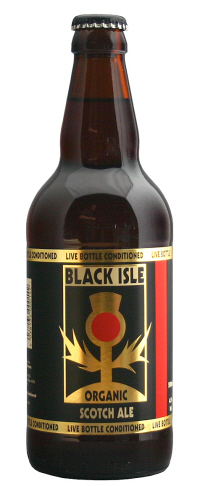 Black Isle Organic Scotch Ale There’s something of a beer renaissance going on in Scotland, with a vibrant micro scene busily innovating as well as reinventing the country’s own distinctive traditional styles. Bottled beers are also playing their part, perhaps unsurprisingly given the cachet of the words “produit d’Ecosse” in the export market.
But sadly, real ale in a bottle remains a rarity. The current Good Bottled Beer Guide lists only three brewers north of the border bottling live beer and one of those, Isle of Skye, offers only a seasonal summer wheat beer.
The second, Bridge of Allan, is responsible for the fine Brig o’Allan 80% which won praise in this column back in 2002 and has gone on to win awards at the Scottish beer festival. The brewery has now added several new organic RAIBs including a porridge oat stout and a ginger-flavoured beer, but sadly sample bottles weren’t available at the time of going to press.
Several other brewers north of the border are also serving the organic market: the only other brewer offering a range of bottled real ales is a dedicated organic specialist. The “intensely independent” Black Isle Brewery was founded by David Gladwin in 1998 at Allangrange, right up in the north near Inverness, on the Black Isle between the firths of Moray and Cromarty.
It now offers four bottle conditioned beers: a wheat beer, a blond and the two review bottles. Organic Scotch Ale and Organic Porter. These are beers you’re as likely to see on the shelves of trendy organic supermarket Fresh & Wild as in a beer shop.
Over the years I’ve found the beers distinctive and vivid but also sometimes a little raw and sharp-edged. The yeast in the sample bottles simply wouldn’t settle and the Scotch Ale came out a very murky, muddy colour, though with a rich off-white head and an attractive aroma with banana milk shake notes.
If you’re hoping for a real bottled version of a traditional malty heavy, you’re in for a surprise: the unusual flavours result partly from the use of whisky-style peated malt and bog myrtle, alongside pale, crystal and wheat malt and Challenger and Goldings hops. The sweetish, gingery palate has acidic orange flavours and a curious herbal cough sweet note, leading to a roasty finish.
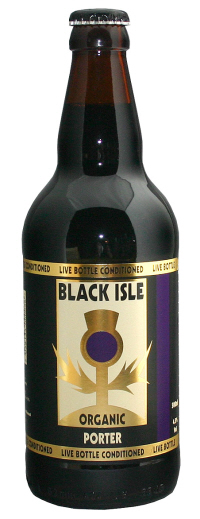 There’s a similar sharpness to the Porter but here it’s more appropriate to the style. A complex grist contains malted wheat and oats alongside pale, crystal and chocolate malts, Challenger and Goldings hops. There’s a similar sharpness to the Porter but here it’s more appropriate to the style. A complex grist contains malted wheat and oats alongside pale, crystal and chocolate malts, Challenger and Goldings hops.
The result is is a dark brown beer with a black coffee aroma and a gravy-like malty palate with roast and liquorice notes. The finish is roastier still with chocolate, malt syrup and faint burry hops.
Read more about these beers at ratebeer.com:
http://www.ratebeer.com/beer/black-isle-organic-scotch-ale/16468/
http://www.ratebeer.com/beer/black-isle-organic-porter/16268/
Originally published in BEER January 2007
ABV: 4.6 and 5 per cent
Origin: Bridgend, Islay (Argyll and Bute)
Buy from: Brewery (tel 01496 810014), local outlets, specialists
Website: www.islayales.com
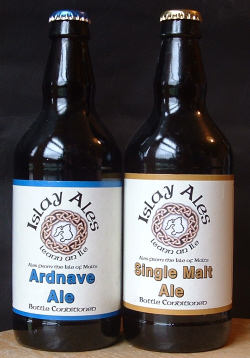 Islay Ales Ardnave Ale and Single Malt Ale I never really “got” whisky until I tasted the pungent, peaty single malts of the Isle of Islay, the southernmost of the Hebrides and the former seat of the Lord of the Isles. So I was delighted to encounter the products of the island’s only brewery, an Anglo-German-run micro launched in 2003.
Supplying craft-brewed bottled ales alongside cask makes real sense in this relatively remote but well-visited location. Islay Ales’ beers trade on the local Celtic heritage and are available in a range of key local outlets including hotels and restaurants.
The brewery – Leann an Ile in Gaelic – boasts a range unusually wide for a small micro hand bottling its beers, and every bottle in the selection I tried, from light session beer Finlaggan Ale to dark and substantial 7.1 per cent Ballinaby Ale, had something to say for itself.
One standout was Ardnave Ale, named after Ardnave Point at the north end of Loch Gruinart. This characterful and refreshing bitter is made from pale malt and “small amounts” of crystal, with four hop varieties – Goldings, Mount Hood, Fuggles and Styrian Goldings.
It’s a warm rich amber with a thick pinkish white head and a pungent, slightly sulphurous aroma with cream and mineral notes. A fruity, biscuity palate is distinctive and unusual, with mineral and complex blackcurrant notes.
The long slightly nutty finish has peppery notes and a hint of ashy roast and, if it doesn’t sound too fanciful, a slight whiff of the seaweed note sometimes found in the island’s whiskies.
There’s an obvious whisky link, too, to Single Malt Ale, originally a special for local malt and music festival the Feis Ile. Amarillo and Bramling Cross hops flavour pure pale malt in this deep golden brew with a creamy white head that, perhaps unexpectedly, emphasises hop character at least as much as malt.
A nettly grapefruit and blackcurrant aroma heralds a very fresh and crisp palate with good malt character, toffee notes and plenty of dry grapefruity hops. The rooty, peppery finish is quite stern and astringent, but with soft fruity malt beneath. Sláinte!
Read more about these beers at ratebeer.com:
http://www.ratebeer.com/beer/islay-ardnave-ale/51591/
http://www.ratebeer.com/beer/islay-single-malt-ale/71980/
Originally published in BEER January 2007
ABV: 3.8 and 4.2 per cent
Origin: Larbert, Falkirk
Buy from: Brewery (tel 01324 554000), specialists
Website www.trystbrewery.co.uk
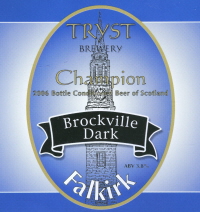 Tryst Brockville Dark Hogmanay is imminent as this issue leaves the press, with Burns Night soon to follow, so it’s the time of year for this column to look north of the border.
In previous years I’ve bemoaned the relatively rarity of Real Ale in a Bottle in an otherwise innovative and dynamic Scottish craft brewing scene. That situation now seems to have changed decisively, with several new names appearing in the recent Good Bottled Beer Guide and others expanding existing ranges.
And there’s more to follow: I was particularly excited to hear that Williams Brothers, originators of Fraoch heather ale, plan to bottle condition some lines, though samples weren’t ready by the time of writing.
With its generally rugged geography and low population density, Scotland will always be a challenge for cask ale producers, partly explaining why its brewers once embraced keg even more wholeheartedly than their English counterparts.
So RAIBs surely have a key role to play as a way for pubs and restaurants even in the remotest corners of the Highlands to offer a choice of natural and distinctive regional bottled beers, much as many of them already do with the country’s standout whiskies.
Then there’s the important tourist trade, and an export market fuelled by both the Scottish diaspora and the romantic and distinctive image Scotland enjoys in the eyes of the world’s consumers.
Tryst Brewery, in the small town of Larbert, near Falkirk in the Central Belt, is one of the new RAIB specialists. Owner John McGarva is a former home brewer who went commercial in 2004, and the brewery name, pronounced to rhyme with “spiced”, commemorates Falkirk’s historic cattle market.
John started by brewing cask, but following requests from drinkers he soon invested in a small bottling plant, and found his bottled beers winning acclaim. A varied and interesting selection of five RAIBs are now available, all in elegant bottles bearing distinctive labels featuring Falkirk’s town steeple.
Tryst won Champion Bottle Conditioned Beer of Scotland 2006 for Brockville Dark, an unusual example of a Scottish-brewed mild named after Falkirk FC’s ground at Brockville Park. It’s made from Optic pale, crystal, amber and chocolate malts, roasted barley and Challenger and Goldings hops.
The result is a dark brown beer with a ruby note, an off-white foam head, and a minerally, salty aroma with a whiff of roast grain. The soft malty palate is gently tingly and slightly briny, with herb notes, a touch of chocolate and a sting of drying hops.
The beer turns liquoricey in a long lasting and very satisfying roasty finish with hints of coal tar and frothy chocolate.
 Tryst Carronade IPA The well deserved CBoS win was the second in a row for the brewery: in 2005 the RAIB medal went to Carronade IPA, named after a cannon made by a local ironworks and used at the battle of Trafalgar.
The beer is in the modern Scottish rather than the historic English IPA mould, a hoppy golden session ale that invites comparison with Caledonian’s classic Deuchars IPA, but is more robustly and intensely flavoured.
Its clear golden colour and fine but sparse white head result from pure Optic pale malt. Cascade and Columbus hop varieties from Washington State contribute to a fresh and complex aroma of pollen, ginger, lemon grass and elderflower.
There’s more elderflower on a crisp and very dry palate with a smooth malty backdrop. A citric swallow leads to a biscuity finish with a firm peppery hop bite, pineapple notes and a late hint of grapefruit.
What’s especially remarkable is that Carronade’s 4.2 per cent ABV is currently as strong as Tryst gets – John skilfully packs massive amounts of flavour into modest gravities, and still ensures the beers work well in bottle.
Tryst Brockville Dark was also featured as a mild for May in BEER May 2009. To read the previous review in this piece, see Hoggleys Mill Lane Mild.
Finally, one of my favourite craft-brewed bottled milds comes from north of the border, where the distinct, and now near-extinct, 60/- style originally filled mild’s ecological niche. Tryst Brockville Dark, from Larbert near Falkirk is a well-balanced award-winning interpretation with a gently tingly and slightly briny malty palate and a liquorice and frothy chocolate finish. Smooth and suave perhaps, of manners gentle and affections mild indeed.
Read more about these beers at ratebeer.com:
http://www.ratebeer.com/beer/tryst-brockville-dark/33826/
http://www.ratebeer.com/beer/tryst-carronade-ipa/39477/
First published in BEER December 2005
Origin: Lochristi, East Flanders, Belgium
ABV: 7.5 per cent
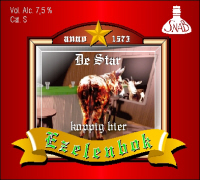 Dutch autumn bokbier must be one of the most underpublicised beer styles outside its home country: world beer surveys often don’t mention it all, or treat it as a footnote to German Bock. Yet it’s really a style in its own right, and in the Netherlands it holds a special place at the heart of the craft beer revival. Dutch autumn bokbier must be one of the most underpublicised beer styles outside its home country: world beer surveys often don’t mention it all, or treat it as a footnote to German Bock. Yet it’s really a style in its own right, and in the Netherlands it holds a special place at the heart of the craft beer revival.
The annual Bokbierfest at the end of October in Amsterdam is the world’s only major beer festival dedicated to a single style, and attracts thousands from all over the Netherlands and beyond. To coincide with the festival, a series of panel tastings names the tastiest boks, and this year top prize went to Ezelenbok (Donkey’s Bock).
The fact that this beer is not actually brewed in the Netherlands but in Belgium is yet another twist in the intriguing history of a border-crossing style from a small trading nation.
The town of Einbeck in Lower Saxony, Germany, claims credit for inventing Bock, and the local brewery, now part of the vast Radeberger group, still labels its strong beers “Ur-Bock”, original Bock. The word “Einbecker”, so the story goes, got mangled into “Bock” when the style took root in Bavaria. But the fact that the word “Bock” (or “bok” in modern Dutch spelling) means billy goat in both German and Dutch indicates a simpler explanation for the origin of the name.
German Bocks are strong lagers, often pale or amber and associated with the spring season, but Dutch boks are dark winter warmers. They first appeared in the late 19th century, when Dutch commercial brewers were converting to cold fermentation and buying in German kit and expertise, so were originally probably always brewed as lagers.
Prior to 1913, boks appeared in February but the start of the season has since suffered a century of anticipation creep, slipping back past Christmas to the beginning of October by 1950. This year it was moved still earlier to 21 September which, given the warm weather, has resulted in the unlikely sight of drinkers enjoying a bok while basking in the sun on café terraces.
By the early 1980s, bok was one of the only alternatives to the ubiquitous “pils” churned out by Heineken and its competitors, and was itself coming under threat. Resistance arrived in the form of PINT, the Dutch beer consumers’ organisation which celebrated its silver anniversary this year. Bokbier was PINT’s early cause célèbre and the annual festival, originally started by a pioneering speciality beer pub, became a flagship event.
The revived interest in speciality beer spearheaded by PINT led to a new wave of Dutch microbrewers. Since most of these were equipped for ale rather than lager production, a new style of warm-fermented bok emerged, often unfiltered and unpasteurised. This development has offered a rare opportunity to compare both ale and lager interpretations of the same basic style side to side.
Today’s bokbiers offer a surprisingly wide range of flavours united by a few key themes. All the beers are dark (ruby red or brown, though some brewers now offer a paler spring variant), strong (the classic gravity is 6.5 per cent but some go up to 8 or 9) and malt-accented. Balancing bitterness comes more from roasted grain than hops.
Broadly, the lager versions are smoother, more consistent and more reliable, while the ales are fruitier, often more complex, and sadly more hit-and-miss in terms of consistency and quality.
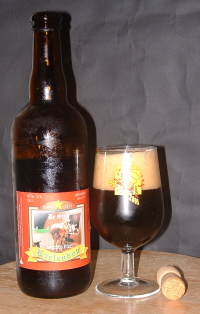 Proef SNAB Ezelenbok Ezelenbok is a bottle- and cask-conditioned ale-style bok that can’t be faulted for quality, perhaps because it emerges not from a tiny Dutch micro but from Belgium’s Proef brewery, where they specialise in brewing small batches under contract. It’s commissioned by SNAB (The North Holland Alternative Brewers’ Society), who also devise and market several other excellent specialities.
Such “brewers without breweries” are more common in countries like the Netherlands and although the arrangement might provoke suspicion from British drinkers, SNAB are honest and transparent about it, with the brewery of origin clearly stated on the label as well as a full ingredients list: Munich, crystal, pilsener and chocolate malts, and Hallertau Hersbrücker hops.
The beer itself is a superb and very refined example of an ale-type. It’s a very dark burgundy (80 EBC) with a thick foamy fawn head and a candyish malty aroma with herbal, blackcurrant and liquorice traces.
A smooth, malty and very nutty palate yields a sweetness balanced by good roasty notes and burry hops (32 EBU), leading to a long dry slightly herbal finish softened by light fruity syrup. The brewer advises up to one year maturing in bottle but it could probably develop for a longer period.
Unfortunately, I’ve never seen a Dutch bok on sale in Britain, but if you’re in Amsterdam over the next couple of months you’ll find a great selection of bottled boks at the Bierkoning beer shop just round the corner from Damplein (Paleisstraat 125, tel +31 (0)20 625 2336, www.bierkoning.nl ). Comparing Ezelenbok with one of the better lager styles like Amstel or Brand is a good place to start exploring this intriguing seasonal style.
Read more about this beer at ratebeer.com: http://www.ratebeer.com/beer/snab-ezelenbok/18134/
Originally published in What’s Brewing November 2005
Origin: Burton Upon Trent, Staffordshire, England
ABV: 5.6 per cent
Buy from supermarkets
 White Shield Worthington White Shield Worthington White Shield was already a historic beer when CAMRA was founded in 1971. Then, it was one of only five bottle conditioned beers still in commercial production in the UK, only three of which are still around today.
It originated at Burton’s Worthington brewery in the 1820s as India Pale Ale, a domestic interpretation of the new, clear and hoppy ales that were proving so successful in the export market. The White Shield name, from the brewery trademark, came later, and survived the 1927 takeover and closure of Worthington by neighbour and rival Bass, while the beer flourished as a nationally distributed brand.
Miraculously, it retained its traditional bottle conditioning, and in the 1960s and 1970s became a welcome beacon in many a keg-only pub, with its own special glass and the need for careful pouring contributing to a growing cult status. Another quirk was its capacity for bottle ageing, normally the preserve of much stronger beers – devotees swore by at least six months and some even talked of years.
The good times couldn’t last forever: during the 1990s White Shield weathered a move from the union sets and even out of Burton, finally moving to King & Barnes in Horsham who licensed the brand when Bass lost interest in 1997, only to be bought and closed themselves in 2000.
But White Shield survived, returning to Burton and to the working micobrewery in Bass’s museum, now the Coors Visitor Centre. It’s even enjoyed a modest marketing push, with a new label – though hardly an improvement on the traditional design which had survived almost unchanged for decades – and numerous supermarket listings. The Museum Brewery has even been renamed the White Shield Brewery.
All this disruption has inevitably led to complaints that White Shield ain’t what it used to be. In the absence of detailed notes on the old Bass-brewed version, I can’t offer a definite opinion on such claims, but White Shield remains a very good beer.
The beer pours a beautifully glowing golden-amber, with a smooth near-white head and a notably lively sparkle. There’s fruity malt, barley sugar, orange, spicy flowery hops and apple tones on the aroma. A slightly sweet biscuity malt palate has emerging rooty hop flavours with a trace of ginger nuts and cough candy: it’s substantial but still light and refreshing.
A creamy swallow leads to a tasty finish with more barley sugar and apple core, with peppery, lettuce-bitter hops emerging slowly but surely in a beautifully long development. This isn’t just a museum piece but a delicious contemporary classic: here’s to the next two centuries.
Read more about this beer at ratebeer.com: http://www.ratebeer.com/beer/worthington-white-shield/286/
Originally published in What’s Brewing July 2005
Origin: Villers-devant-Orval, Luxembourg province, Belgium
ABV: 6 per cent
Buy from specialist suppliers
Website www.orval.be
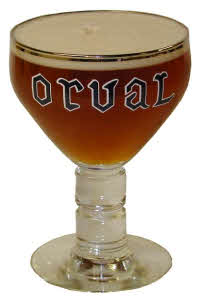 Orval Orval is one of the world’s most unusual and distinctive ales as well as one of its finest. It’s one of the family of Belgian beers brewed under the supervision of Trappist monks, but even among this select band it stands out as something different and special.
The monks of Orval, in the attractive wooded countryside of the Ardennes, concentrate on only one beer, which eschews the plump, fruity sweetness of most Trappist brews in favour of a comparatively low gravity and a big hop accent achieved, unusually for Belgium, by dry hopping.
Commercial brewing dates from 1931. The distinctive art deco design style of the bottle, label and glass has survived almost unchanged since then: though delightfully retro today, in its time it would have been as audaciously uncompromising as the beer.
A dash of caramalt colours a mainly pale malt mash, with local spring water and Bavarian Hallertau and Czech Styrian Goldings hops. Primary fermentation is with a pure cultured yeast, but a more complex mix including some wild yeast strains is then used for a three week secondary fermentation. The beer is bottled unpasteurised with priming syrup and matured for a further five weeks before release.
Even drunk young, the result it is bursting with complex aromas and flavours that are perfect to enliven a warm summer night. Resist the temptation to chill: it’s best served at cellar temperature (10-15°C) and the brewery recommends pouring without the deposit, then adding it later if wished.
The beer pours a rich peachy amber, with a thick smooth off-white head and a spicy aroma rich in hops and kumquat orange scents. It’s thick-textured on the palate but not sweet, with big pepper hops and deep, fecund herb flavours, a trace of leather and tobacco, a dash of acidity and a trace of warming alcohol.
A lively bead turns milky on the swallow, leading to a dryish and very peppery finish. Rootier notes emerge over a long development, with traces of sweet fruit, rolling tobacco, cloves and sulphur.
It can also be cellared for up to five years and becomes even more intense and complex as it ages: on a two-year-old bottle I noted intoxicating sandalwood incense on the aroma and a fantastically complex palate with more developed notes of fennel, cloves and fresh fruit marmalade. Sappy, bitterish Indian spices stood out in the finish.
If ever there was a beer with which to challenge the wine snob, then it’s this one, but perhaps we should be careful – a wine that could match Orval in complexity would most likely cost ten times as much!
Read more about this beer at ratebeer.com:
Originally published in What’s Brewing June 2005
Origin: Faversham, Kent, England
ABV: 6.5 per cent
Buy from supermarkets
Website www.shepherd-neame.co.uk
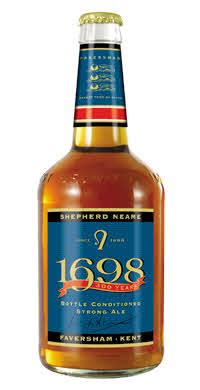 Shepherd Neame 1698 Shepherd Neame helped pioneer the new generation of real ale in a bottle back in the mid-1990s, when a gorgeous version of Spitfire, now the brewery’s biggest seller in cask, found its way onto supermarket shelves. I regarded bottled Spitfire as a near-world classic, considerably tastier than its draught counterpart. The Champion Beer of Britain judges also recognised its virtues, awarding it a bronze medal in its class in 1994.
However, consistency and quality problems persuaded the brewery to replace the real thing with a filtered and pasteurised version. I first tried the new Spitfire without noticing that the words “bottle conditioned” had disappeared from the label, but quickly noticed something was amiss. This beer, though pleasantly tasty, was several notches down and rather lifeless, a clear example of what a difference live yeast can make.
Now Sheps are once again experimenting with real ale in a bottle, only this time at a higher strength to help minimise the problems. Like Spitfire, originally a special for the 50th anniversary of the Battle of Britain, 1698 first appeared as celebratory draught ale, marking the brewery’s 300th birthday in 1998.
Those three and a bit centuries support Sheps’ claim to being Britain’s oldest brewery, and they’re keen on local identity as well as tradition. Up in the north of Kent, near the Swale, they’re close to some of Britain’s best hop country – the beers have an appropriately hoppy accent, and 1698 is no exception.
Target goes in first, followed by two doses of East Kent Goldings. The Pearl pale ale malt is also sourced within the county, and there’s a dose of crystal too, giving a rich amber-chestnut colour with a moderate but persistent white head. You catch the fecund, earthy, slightly sweaty whiff of Goldings the moment you open the bottle.
The aroma settles a bit in the glass, with toasty malt and boiled sweets coming to the fore. A rich, nutty, toffeeish palate has complex hints of dried fruit, marzipan and slightly spicy hops, but remains fresh and fruity despite the heftiness.
The beer turns peppery on the swallow, with a nicely balanced finish that slowly unfolds to reveal fresh fruit, rounded bitterness and more rooty, spicy flavours. There’s a late touch of sweetish sherry.
It’s heartening to see a brewer of Shep’s stature return to the Real Ale in a Bottle fold with as fine an example as this. They should reconsider using their traditional clear glass bottle in this case, though — it might look nice, but it won’t do the contents any favours.
Read more about this beer at ratebeer.com: http://www.ratebeer.com/beer/shepherd-neame-1698/4143/
Originally published in What’s Brewing May 2005.
This beer has since been discontinued.
Origin: St Peter Port, Guernsey, Channel Islands
ABV: 3.5 per cent
Buy from supermarkets
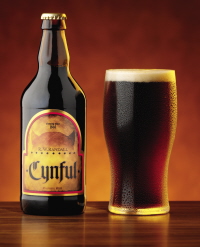 R W Randall Cynful It’s been an interesting year for bottled milds. Not only have more real milds appeared in bottle, but an excellent new example, craft brewed though sadly filtered and pasteurised, has found itself nationally distributed by a major supermarket chain.
That mild is Cynful, from sunny Guernsey, far from mild’s Black Country heartland. You’ll find the word “mild” in very small letters within a playfully decadent packaging design that bravely addresses trendy young things of both sexes rather than old codgers in cloth caps. Perhaps the local French connections have helped nurture a sense of style!
The brewery, R W Randall, dates from 1868, when a member of a brewing family from Jersey headed northwest to set up on his own. It’s now in its fifth generation of family control, with 18 pubs. Cynful takes its name from one of the brewery’s longstanding licensees, Cyndi de Jersey, who originally requested a cask version of what was then the brewery’s “bright” dark mild.
When Randall decided to enter the Tesco Beer Challenge in Spring 2004, they opted for a modification of draught Cynful. The beer won, leading to a year’s contract with Tesco, which may be renewed, and the brewery is also in talks with other supermarkets.
Bottled Cynful is a pure malt brew made from pale ale, crystal and chocolate malt and hopped with Sussex Fuggles and Styrian Goldings, with a dash of Challenger. It uses the brewery’s house yeast strain, descended from a yeast that originally came from Eldridge Pope of Dorchester back in the 1940s.
It pours a dark amber-brown, with a soft, close, just off-white head. The restrained aroma is gently hoppy and roasty with some fruit and a touch of vanilla. The palate is light but creamy and very tasty, delivering maximum flavour from a low gravity in classic mild fashion.
The flavour begins with malted milk notes reminiscent of German dark lagers, soon lifted by tangy hops and blackcurrant and orange notes. A refreshing swallow leads to a gently hoppy finish, with more malt, a subtle blackcurrant fruitiness and fleeting roast and charcoal touches.
So why not make this fine beer even finer by bottle conditioning it? The brewery’s Ben Randall tells me this was discussed, but given the lack of experience, the long distances and the low gravity, was judged too much of a risk. However the brewery is now enthusiastic about its cask beer range, and is planning further forays into the premium bottled ale market, so the possibility isn’t ruled out. And judging by the experience of landlady Cyndi, it’s always worth asking.
Read more about this beer at ratebeer.com: http://www.ratebeer.com/beer/randalls-cynful/37958/
Originally published in What’s Brewing April 2005.
Origin: Fürstenfeldbruck, Bavaria, Germany
ABV: 5.5 per cent
Buy from specialist suppliers
More information www.kaltenberg.de
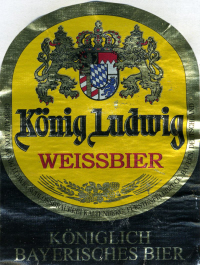 Kaltenberg König Ludwig Weissbier The connection between royalty and beer has perhaps never been so deep as in Bavaria, where secular, commercial brewing is a surprisingly recent invention. For most of recorded history, brewing in the historic south German territory was carved up between the church and the crown.
The Wittelsbacher dynasty, who ruled Bavaria over an astonishingly long period from 1180 to 1918, jealously guarded their grip on the local industry and especially their monopoly on wheat beer brewing, with taxes on beer making up a hefty slice of their wealth. It was a Wittelsbacher, Wilhelm IV, who passed the celebrated Reinheitsgebot (purity law), while another, Ludwig I, established the Oktoberfest, and in total the family has founded around 70 breweries.
Today Bavaria is a part, albeit a fiercely independently-minded one, of the Federal Republic of Germany, but the family is still around and still maintains its beery connections. Prince Luitpold, great-grandson of the last king, Ludwig III, revived the brewery in the cellar of his family pile, Kaltenberg Castle at Fürstenfeldbruck, east of Munich, back in 1976.
The prince built his brewing reputation on a traditional dark lager, König Ludwig Dunkel, but there are many other beers in the range and more recently he’s turned his attention to the style most associated with his ancestors: wheat beer.
König Ludwig Weissbier is a traditional cloudy, unpasteurised Bavarian wheat beer which also sometimes appears under the name Prinzregent Luitpold – dark, “kristall” (filtered) and low alcohol variations are also available under this latter name.
The classic light unfiltered version pours a typical yellow-golden colour, with a thick and smooth white head. There’s a beautifully fresh and spicy aroma, very wheaty with hints of new-mown hay, lime marmalade, roses, apple and cinnamon.
The palate is also smooth and clean but with a rich and robust graininess supporting flavours of custard cream with more apples and roses. It’s soft and milky, with emerging apple and slightly pippy hops, easily drinkable but very satisfying.
A more drying swallow leads to a tangy finish that still has a good creaminess, with slight strawberry hints. More wheaty cereal tastes emerge and the beer leaves you with well-rounded hops.
The beer’s fresh fruitiness gives it a distinctive edge which, in the hyper-traditional world of Bavarian brewing, does not always appeal to those weaned on more established wheat beer brands. But, speaking as a confirmed republican, I think it’s a delightful example, exquisitely balanced and well deserving of its place alongside the brewery’s benchmark dark lager.
Try also Schneider Weisse Original, Franziskaner Hefe-Weissbier, Unertl Weissbier, Baltika 8 Pshenichnoe Svetloe (Russia)
Read more about this beer at ratebeer.com: http://www.ratebeer.com/beer/konig-ludwig-weissbier/8946/
Originally published in What’s Brewing March 2005.
Note this brewery has since closed.
Origin: Llangefni, Isle of Anglesey, Wales
ABV: 4 and 4.5 per cent
Buy from local sources, brewery
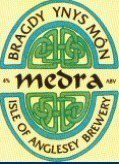 Ynys Môn Medra Only four Welsh breweries offering real ale in a bottle are listed in the current Good Bottled Beer Guide, and with St David’s Day only days away when this issue hits the streets, I’ve finally had a chance to feature one of them in this column.
Though small, Bragdy Ynys Môn – that’s ‘Isle of Anglesey Brewery’ in Saesneg – can still lay claim to being the biggest brewery in northwest Wales. It’s located in a farmhouse in open countryside in the southeast of the island, within sight of Snowdonia, where it’s been since it was founded by Martyn Lewis in 1999.
An enthusiastic bottler, the brewery has its own line, a shrewd investment given its location in a far-flung corner of the nation. All the beers are racked straight from the cask, unfiltered, unfined and vegan-friendly. With the help of Martyn I picked out two from a range of six to feature here, both of them beers of quality and distinction.
Medra (4 per cent), the most distinctive of the two by a hair, is a cheerful bitter with a stylish American twist from using Cascade hops alongside Fuggles. The name means ‘I can’ and refers to a local tradition that the island’s people were especially versatile, always giving this answer when asked if they could do a particular job.
Medra pours a lovely sunny amber with a persistent bubbly off-white head. There’s a pronounced honeybush aroma with some more resiny hoppiness.
The palate emphasises the smoky, roasty qualities of crystal malt, veering close to Rauchbier territory but with lots of fruit and a pleasing sweetish chaffiness. There’s more smoke in the finish, with cedarwood and a rounded hop bitterness.
This easy-going beer is as versatile as its name suggests, with a complex enough flavour for the demanding sipper and a drinkable and attractive fruitiness that would suit the food matcher – but at a weak enough strength to quench the thirst too.
Tarw Du (Black Bull, 4.5 per cent), the brewery’s first beer, is a big black stout that’s more intense than its gravity suggests. It pours extremely dark and oily with mushroom-brown lace, giving off the scents of roast nuts, strong drinking chocolate and malted milk.
In the mouth it’s beautifully soft and creamy, but dryish and roasty too, with flashes of sweet and sour fruit. The beer turns tangier on the swallow, with intense ash, roast and bitter chocolate dominating the finish, but with nice tangy fruit making the going very easy indeed. Iechyd da!
Read more about Medra at ratebeer.com: http://www.ratebeer.com/beer/bragdy-ynys-mon-medra/53662/
|
Cask  This pioneering new book explains what makes cask beer so special, and explores its past, present and future. Order now from CAMRA Books. Read more here. This pioneering new book explains what makes cask beer so special, and explores its past, present and future. Order now from CAMRA Books. Read more here.
London’s Best Beer  The fully updated 3rd edition of my essential award-winning guide to London’s vibrant beer scene is available now from CAMRA Books. Read more here. The fully updated 3rd edition of my essential award-winning guide to London’s vibrant beer scene is available now from CAMRA Books. Read more here.
|
 There’s a similar sharpness to the Porter but here it’s more appropriate to the style. A complex grist contains malted wheat and oats alongside pale, crystal and chocolate malts, Challenger and Goldings hops.
There’s a similar sharpness to the Porter but here it’s more appropriate to the style. A complex grist contains malted wheat and oats alongside pale, crystal and chocolate malts, Challenger and Goldings hops.















